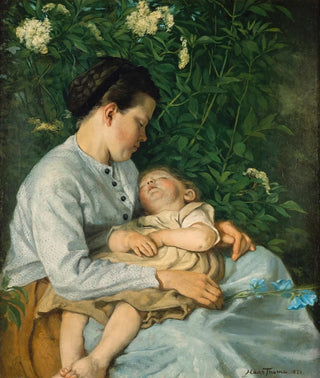Art print | Under the elderberry - Hans Thoma


View from behind

Frame (optional)
Under the Elderberry Tree - Hans Thoma – Captivating Introduction
In the vast universe of art, some works manage to capture the very essence of nature and the human condition. "Under the Elderberry Tree" by Hans Thoma is one of those creations that, through its apparent simplicity, reveals emotional depth and narrative richness. This piece, rooted in the realism movement, transports us to the heart of a bucolic scene where the beauty of German landscapes blends with everyday life. Thoma, with his keen eye and poetic sensitivity, invites us to contemplate a frozen moment in time, where the dialogue between man and his environment unfolds in all its splendor.
Style and uniqueness of the work
Hans Thoma's style is distinguished by its luminous and vibrant approach. In "Under the Elderberry Tree," the colors are carefully chosen to evoke a warm and welcoming atmosphere. The shades of green and yellow, which dominate the canvas, evoke the lushness of nature, while touches of light add an almost magical dimension to the scene. The choice of the elderberry, a tree with strong symbolic connotations, emphasizes the harmony between man and his environment, while echoing universal themes such as peace, serenity, and contemplation. Thoma succeeds in creating a visual space where the viewer is invited to immerse themselves, to feel the gentle air and hear the whisper of the leaves. His technique, combining precision and fluidity, gives the work a unique dynamic, where every detail is meticulously orchestrated to serve captivating visual storytelling.
The artist and his influence
Hans Thoma, an emblematic figure of 19th-century German art, knew how to mark his era with an artistic vision deeply rooted in tradition while embracing the innovations of his time. Influenced by Romanticism and Realism, he developed a personal style that combines faithful representation of nature with a more symbolic and introspective approach. Thoma was also a passionate advocate of popular culture, seeking to valorize the stories and landscapes of his country. His work has inspired many contemporary artists and has contributed to shaping an aesthetic that continues to

Matte finish

View from behind

Frame (optional)
Under the Elderberry Tree - Hans Thoma – Captivating Introduction
In the vast universe of art, some works manage to capture the very essence of nature and the human condition. "Under the Elderberry Tree" by Hans Thoma is one of those creations that, through its apparent simplicity, reveals emotional depth and narrative richness. This piece, rooted in the realism movement, transports us to the heart of a bucolic scene where the beauty of German landscapes blends with everyday life. Thoma, with his keen eye and poetic sensitivity, invites us to contemplate a frozen moment in time, where the dialogue between man and his environment unfolds in all its splendor.
Style and uniqueness of the work
Hans Thoma's style is distinguished by its luminous and vibrant approach. In "Under the Elderberry Tree," the colors are carefully chosen to evoke a warm and welcoming atmosphere. The shades of green and yellow, which dominate the canvas, evoke the lushness of nature, while touches of light add an almost magical dimension to the scene. The choice of the elderberry, a tree with strong symbolic connotations, emphasizes the harmony between man and his environment, while echoing universal themes such as peace, serenity, and contemplation. Thoma succeeds in creating a visual space where the viewer is invited to immerse themselves, to feel the gentle air and hear the whisper of the leaves. His technique, combining precision and fluidity, gives the work a unique dynamic, where every detail is meticulously orchestrated to serve captivating visual storytelling.
The artist and his influence
Hans Thoma, an emblematic figure of 19th-century German art, knew how to mark his era with an artistic vision deeply rooted in tradition while embracing the innovations of his time. Influenced by Romanticism and Realism, he developed a personal style that combines faithful representation of nature with a more symbolic and introspective approach. Thoma was also a passionate advocate of popular culture, seeking to valorize the stories and landscapes of his country. His work has inspired many contemporary artists and has contributed to shaping an aesthetic that continues to






